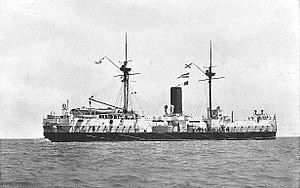| HMS Edinburgh (1882) | |
|---|---|
 | |
| Career | |
| Name: | HMS Edinburgh |
| Builder: | Pembroke Dockyard |
| Laid down: | 20 March 1879 |
| Launched: | 18 March 1882 |
| Completed: | 8 July 1887 |
| Fate: | broken up, 1910 |
| General characteristics | |
| Displacement: | 9,420 tons |
| Length: | 325 ft (99 m) pp |
| Beam: | 68 ft (21 m) |
| Draught: | 25 ft 9 in (7.85 m) |
| Propulsion: | Two-shaft Humphreys inverted direct compound, 6,808 ihp |
| Speed: | 16 knots (30 km/h) |
| Complement: | 396 |
| Armament: |
4 × BL 12-inch (304.8 mm) Mk IV guns |
| Armour: |
Citadel: 18 in–14 in Turrets: 16 in faces, 14 in sides and rear Conning tower: 14 in Bulkheads: 16 in–13 in Deck: 3 in–2½ inches |
HMS Edinburgh was an ironclad battleship of the Colossus class which served in the Royal Navy of the Victorian era. She was the sister ship of HMS Colossus, being started before her but being completed after.
Edinburgh was the first British battleship since HMS Warrior, launched in 1860, to carry breech loading artillery as part of her main armament. Warrior had been equipped with 10 110-pounder Armstrong breech loading guns, which had not proved satisfactory, to complement her 26 muzzle-loaders.
Edinburgh's guns were carried in two turrets positioned near the centre of the ship, and the turrets were mounted en echelon. It was expected that, by mounting the turrets in this way, at least one gun from each turret could fire fore and aft along the keel line, and all four guns could fire on broadside bearings; it was intended that every part of the horizon could be covered by at least two guns. In practice it was found that firing too close to the keel line caused unacceptable blast damage to the superstructure, and cross-deck firing similarly caused damage to the deck.
Before Edinburgh the positioning of the conning tower in British ironclads had produced a variety of solutions; the difficulty was that the two important factors involved, maximum protection and maximum visibility, were essentially mutually incompatible. In this ship the conning tower was positioned forward of the foremast for good all-round vision; the chart-house was, however, placed on its roof, and the whole area surrounded by small guns, stanchions and other obstructions to the view; the problem was not solved until the political will to build larger ships in turn allowed more space for command facilities.
Service history[]
Her completion was delayed due to a lengthier than expected development time for her armament. An example of the Mark II twelve-inch breech loader exploded on board HMS Collingwood while on trial, and Edinburgh had to wait, as did other ships, for the Mark IV. She was commissioned at Portsmouth in July 1887 for the 1887 Golden Jubilee Fleet Review, and was then posted to the Mediterranean, where she was commanded by Commander (later Admiral Sir) Percy Scott until 1890. Her posting to the Mediterranean ended in 1894.
She was then briefly guardship at Hull, and was then guardship at Queensferry until 1897, when she went into reserve. The ship was under the command of Commander C. G. Treherne in 1901. She became a flagship on 1 November 1901, when Vice-Admiral Albert Hastings Markham hoisted his flag on becoming Commander-in-Chief, The Nore.[1]
In 1908 she was converted for use as a target ship, being fitted with fully backed and supported modern armour plates; the intention was to test and measure the effect on these plates of oblique impact by armour-piercing shells filled with lyddite, the most potent explosive of the period. As a result of these trials, which revealed major shortcomings in British high-explosive shells, the Controller, Jellicoe, ordered that the design of these shells should be improved. He was shortly thereafter appointed in command of the British Atlantic Fleet, and this instruction was not carried out. At the Battle of Jutland many British armour-piercing shells either did not pierce German armour, or did so but failed to explode, because of this failing.
References[]
- Brown, D. K. (1997). Warrior to Dreadnought: Warship Development, 1860–1905. London: Chatham Pub.. ISBN 978-1-86176-022-7. OCLC 37334266.
- Chesneau, Roger; Eugène M Koleśnik; N. J. M. Campbell (1979). Conway's All the World's Fighting Ships, 1860–1905. London: Conway Maritime Press. ISBN 978-0-85177-133-5. OCLC 5834247.
- Parkes, Oscar (1990). British Battleships. Cooper. ISBN 978-0-85052-604-2. OCLC 21677208.
| ||||||||
The original article can be found at HMS Edinburgh (1882) and the edit history here.